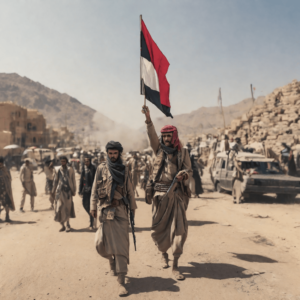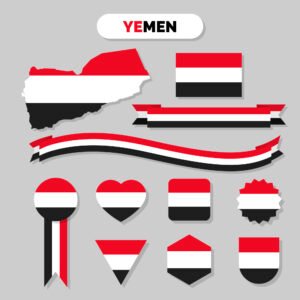- Yemen’s Houthi rebels have entered the Israel-Hamas conflict

Yemen‘s Houthi rebels have entered the Israel-Hamas conflict, despite their location more than 1,000 miles away from their base in Sanaa. They announced on Tuesday that they had launched drones and missiles at Israel, underscoring the regional implications of the ongoing war.
As part of the “Axis of Resistance” with support from Iran, the Houthis have aligned themselves with the Palestinian cause since Hamas initiated an attack on Israel on October 7. This has added a new dimension to the conflict, as the Houthis have been engaged in an eight-year-long war against a Saudi-led coalition in the Gulf.

Yemen, a nation located in the southwestern part of the Arabian Peninsula, has been a focal point of global attention due to its tumultuous geopolitical landscape. The ongoing conflicts, a complex web of alliances, and humanitarian crises have made Yemen a challenging puzzle to decipher. In this article, we will delve into the intricate geopolitical landscape of Yemen, exploring the current political climate and its implications.
Yemen’s Historical Backdrop
Understanding Yemen’s current geopolitical situation requires a grasp of its historical context. Yemen has been a nation divided for centuries, characterized by regionalism and tribal affiliations. This division played a significant role in shaping the country’s political landscape, and it continues to influence contemporary Yemeni politics.
The Arab Spring and Yemen’s Uprising
The Arab Spring, a series of protests and uprisings across the Arab world, reached Yemen in 2011. These protests ultimately led to the overthrow of Yemen’s then-President, Ali Abdullah Saleh, who had ruled the country for over three decades. However, this was just the beginning of Yemen’s turbulent journey.
Houthi Insurgency and the Saudi-Led Coalition
In September 2014, Houthi rebels, backed by Iran, took control of Yemen’s capital, Sanaa, and later ousted the government of President Abdrabbuh Mansur Hadi. This prompted a military intervention by a Saudi-led coalition in March 2015. This ongoing conflict has had devastating consequences for the Yemeni people, resulting in a severe humanitarian crisis.
Yemen’s Factional Divisions
 Yemen’s political landscape is marked by multiple factions, each with its own interests and alliances. Key players include:
Yemen’s political landscape is marked by multiple factions, each with its own interests and alliances. Key players include:
Houthis (Ansar Allah): This Shiite rebel group hails from northern Yemen and is backed by Iran. The Houthis control significant parts of the country, including the capital, Sanaa.
Yemeni Government: President Hadi’s internationally recognized government, backed by the Saudi-led coalition, operates from exile in Saudi Arabia.
Southern Transitional Council (STC): This separatist group aims to establish an independent South Yemen and has clashed with both the Houthis and the Yemeni government.
Al-Qaeda in the Arabian Peninsula (AQAP): This extremist group has exploited the chaos to expand its influence in Yemen.
Tribal Militias:
Various tribal groups exert regional influence, often siding with different factions in the conflict.
The Role of External Actors
Yemen’s geopolitical landscape is further complicated by the involvement of external actors. Iran’s support for the Houthi rebels and Saudi Arabia’s leadership in the coalition supporting the Yemeni government are primary examples. The United States has also played a role in providing military assistance to the Saudi-led coalition. Additionally, the United Arab Emirates (UAE) has supported the Southern Transitional Council in the south. This external involvement has exacerbated the conflict and its consequences.
Implications of Yemen’s Political Climate
The complex geopolitical situation in Yemen has far-reaching implications, both regionally and globally.
Humanitarian Crisis:
Yemen is facing one of the world’s most severe humanitarian crises. Conflict has disrupted essential services, leading to widespread famine, disease, and displacement. Millions of Yemenis are in dire need of humanitarian assistance.
Security Threats:
The instability in Yemen has allowed extremist groups like AQAP to thrive, posing a security risk not only within Yemen but also internationally.
Regional Rivalry:
The conflict in Yemen is a manifestation of the broader regional rivalry between Iran and Saudi Arabia, intensifying sectarian tensions in the Middle East.
Refugee Crisis:
The ongoing conflict has driven many Yemenis to seek refuge in neighboring countries, adding to the strain on regional resources and infrastructure.
Diplomatic Efforts:
Diplomatic efforts have been made to resolve the conflict, including the United Nations-led peace talks. However, a lasting resolution remains elusive, primarily due to deep-rooted divisions and external interests.
Yemen’s complex geopolitical landscape is a testament to the challenges of navigating regional and international interests. The current political climate, influenced by “Resistance Axis” have increased the risks of conflict in the region.

Resistance Axis
The Houthis are a significant faction within the “Axis of Resistance,” which opposes Israel and the United States and has been carrying out attacks across the region since October 7.
Iran-supported Iraqi militias have been engaging in hostilities against U.S. forces in Iraq and Syria, while Lebanon’s Hezbollah has been involved in clashes with Israeli forces along the Lebanese-Israeli border.
The Houthis have showcased their missile and drone capabilities in the Yemen conflict, launching attacks on Saudi Arabia and the United Arab Emirates. The Saudi-led coalition has accused Iran of arming, training, and financing the Houthis, although the group denies being an Iranian proxy and claims to develop its own weaponry.
The United States, Israel’s primary ally, has deployed aircraft carriers to act as a deterrent against the expansion of the Gaza conflict. Iran has also expressed a desire to prevent the conflict from spreading.
However, on Tuesday, Iranian Foreign Minister Hossein Amirabdollahian hinted that Tehran’s allies may take further action.
During a meeting with the Emir of Qatar, Iranian Foreign Minister Hossein Amirabdollahian stated, “Resistance groups will not remain silent in the face of the Zionist regime’s crimes and America’s full support for the Zionist regime.” He emphasized that these groups wouldn’t wait for guidance and warned that if the situation escalated further, no party would be immune from the consequences, as reported by Iranian state media.
Houthi spokesperson Saree attributed the growing instability in the Middle East to Israel’s “continued crimes,” expanding the “circle of conflict” in the region. He asserted that the Houthi attacks would persist until Israeli aggression ceased.
Mohanad Hage Ali, an expert from the Carnegie Middle East Centre, noted that although some Houthi missiles and drones had been intercepted in recent hostilities, their attacks currently appeared to be more of a messaging strategy than a substantial military threat. He pointed out that the main risk to Israel would arise in the event of a comprehensive engagement involving multiple rocket launches from various directions that could potentially overwhelm Israel’s air defenses.